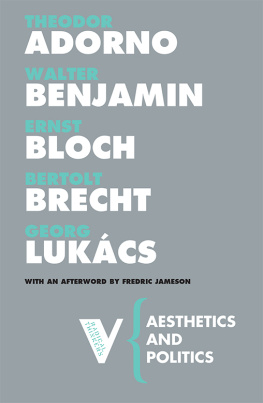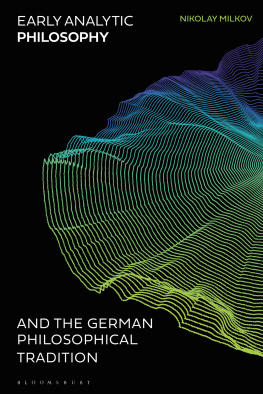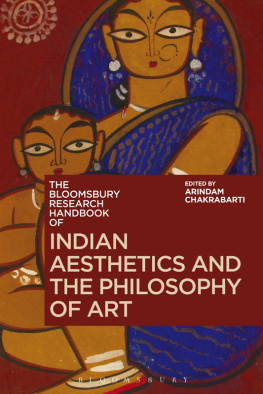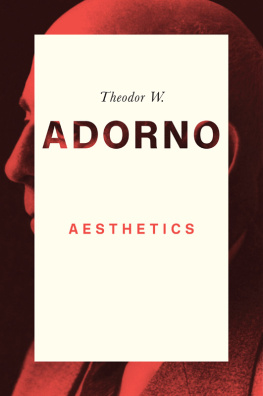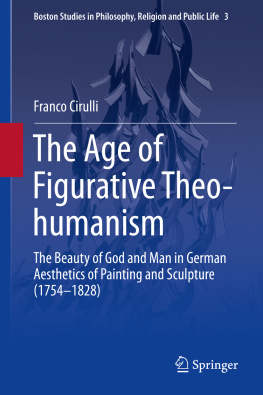NEW DIRECTIONS IN GERMAN STUDIES
Vol. 16
Series Editor:
Imke Meyer
Editorial Board:
Katherine Arens, Roswitha Burwick, Richard Eldridge, Erika Fischer-Lichte, Catriona MacLeod, Stephan Schindler, Heidi Schlipphacke, Ulrich Schnherr, James A. Schultz, Silke-Maria Weineck, David Wellbery, Sabine Wilke, John Zilcosky.
Volumes in the series:
Vol. 1. Improvisation as Art: Conceptual Challenges, Historical Perspectives
by Edgar Landgraf
Vol. 2. The German Pcaro and Modernity: Between Underdog and Shape-Shifter
by Bernhard Malkmus
Vol. 3. Citation and Precedent: Conjunctions and Disjunctions of German Law and Literature
by Thomas O. Beebee
Vol. 4. Beyond Discontent: Sublimation from Goethe to Lacan
by Eckart Goebel
Vol. 5. From Kafka to Sebald: Modernism and Narrative Form
edited by Sabine Wilke
Vol. 6. Image in Outline: Reading Lou Andreas-Salom
by Gisela Brinker-Gabler
Vol. 7. Out of Place: German Realism, Displacement, and Modernity
by John B. Lyon
Vol. 8. Thomas Mann in English: A Study in Literary Translation
by David Horton
Vol. 9. The Tragedy of Fatherhood: King Laius and the Politics of Paternity in the West
by Silke-Maria Weineck
Vol. 10. The Poet as Phenomenologist: Rilke and the New Poems
by Luke Fischer
Vol. 11. The Laughter of the Thracian Woman: A Protohistory of Theory
by Hans Blumenberg, translated by Spencer Hawkins
Vol. 12. Roma Voices in the German-Speaking World
by Lorely French
Vol. 13. Viennas Dreams of Europe: Culture and Identity beyond the Nation-State
by Katherine Arens
Vol. 14. Thomas Mann and Shakespeare: Something Rich and Strange
edited by Tobias Dring and Ewan Fernie
Vol. 15. Goethes Families of the Heart
by Susan E. Gustafson
In memory of Jochen
German Aesthetics
Fundamental Concepts from
Baumgarten to Adorno
Edited by
J. D. Mininger
and Jason Michael Peck
Bloomsbury Academic
An imprint of Bloomsbury Publishing Inc
Contents
The idea for this book arose well over ten years ago, based largely on the impulse to produce a volume to honor our mentor, Jochen Schulte-Sasse. Mirko Hallour friend, a contributor to this volume, and a fellow student of Jochensprovided crucial support in the early stages. Three othersRichard Leppert, Thomas Pepper, and Jack Zipes, all close friends and colleagues of Jochen, and our teachersgave decisive counsel and encouragement. From its incipience to its publication, Silke-Maria Weineck has given us invaluable guidancethank you, Silke! We are grateful to all of the volumes contributors for their patience and commitment to the book. We thank Lindsay Waters for helping us to develop the project. We would also like to thank the team at Bloomsbury: Haaris Naqvi, Mary Al-Sayed, and especially New Directions in German Studies series editor Imke Meyer. We are grateful to the books anonymous reviewers, whose insights and suggestions improved the volume.
Jason would like to thank Leslie Morris, Jack Zipes, Susan Gustafson, Jennifer Creech, Marynel Ryan Van Zee, Jason Middleton, Joshua Dubler, Lisa Cerami, Nora Rubel, and Aaron Hughes for their advice and friendship during the gestation of the project. I would like to dedicate this volume to my parents and to Sy, Vi, and Hal, who prove to me every day the existence of the beautiful and the sublime.
For their patience, friendship, and encouragement, J.D. wishes to thank: Tomas Berkmanas, Gintautas Maeikis, Jurga Jonutyt, Leonidas Donskis, Marlene Wall, Niels Jrgen Cappelrn, Jon Stewart, Thomas Pepper, Richard Leppert, Bartholomew Ryan, Benjamin Olivares Bgeskov, Christian Mller, Daro Gonzlez, Christian Sieg, Fabian Goppelsrder, Andrew Knighton, and Brynnar Swenson. I am especially grateful to my parents for their constant support, and to Elijus, Nojus, and Vilma for their laughter, joy, and patience.
It is heartbreaking for us that the person we would most like to thankJochen Schulte-Sassedied in December, 2012. We are proud to dedicate this book to his memory. Words from an obituary written by Mirko Hall best express our own thoughts and feelings:
[Jochen] provided his students with an unwavering model of academic excellence, while exuding those qualities of Allgemeinmenschlichkeit that were valorized by the eighteenth-century German thinkers whom he so deeply admired: compassion, humility, kindness, and patience. One is reminded here of that wonderful passage from Lessings Emilia Galotti , a text that he loved: possessing das Ideal hier ( mit dem Finger auf die Stirne )oder vielmehr hier ( mit dem Finger auf das Herz ), Jochen will always be remembered for this beautiful synergy of intellect and heart.
Thank you, Jochen.
The German-speaking intellectual world has played a unique role in the history of philosophical aesthetics. Many of the foundational concepts and texts of aesthetic theory come from the German-speaking traditionfor instance: the notions of aesthetic autonomy and disinterestedness developed in Immanuel Kants landmark Critique of Judgment ; Friedrich Schillers writings on grace and dignity as well as the aesthetic state in the 1790s; Hegels provocative claims about the end of art; Friedrich Nietzsches seminal theories of artistic form and motivation in The Birth of Tragedy ; or Adornos dense, powerful Aesthetic Theory . The names of German thinkers inundate nearly every canonical account of the history and field of aesthetics, including such figures as Lessing, Schlegel, Schelling, Schopenhauer, Heidegger, Brecht, Benjamin, and Gadamer, just to name a prominent few. Indeed, it is fair to say that without Kants Critique of Judgment , modern aesthetics as we know it would be inconceivable.
The term aesthetics was coined by a German-speaking writer, Alexander Baumgarten, whose Meditationes philosophicae de nonullis ad poema pertinentibus (translated as Reflections on Poetry ) is both the canonical starting point of the German aesthetic tradition and equally the founding text of modern aesthetics. Baumgarten reorients philosophy away from genuine knowledge and self-evident logic, towards sensation and perception: Philosophers might still find occasion, not without ample reward, to inquire also into those devices of by which they might improve the lower faculties of knowing, and sharpen them, and apply them more happily for the benefit of the whole world. Baumgartens project of aesthetics required a new semiotic constellationnew terminology, new epistemic orientation, and a reassessment of philosophys definitions and tasks. In the wake of Baumgartens vision of aesthetics, the German tradition would play a role of unparalleled importance in providing aesthetics with its own intellectual terms and frames of reference.
Inspired in part by the emphasis aesthetics has continually placed on terminology, this volume presents accessible entry points into significant questions and debates of philosophical aesthetics through the broadly influential German aesthetic tradition and its key terms and concepts. Because concepts from the German aesthetic tradition inform diverse perspectives in other language area studies, as well as in continental philosophy and art theory generally, the book both contributes to and exceeds the boundaries of German studies. German Aesthetics provides English-speaking audiencesfrom uninitiated readers to advanced students and scholars alikewith a reference tool containing fundamental terms and conceptual narratives of the German tradition of philosophical aesthetics from Baumgarten to Adorno (roughly 17501970).



